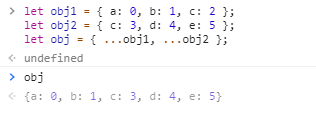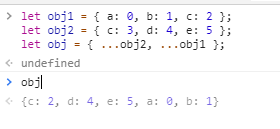1.格式化金钱值 const ThousandNum = num = num.toString().replace(/\B(=(\d{3})+(!\d))/g, ",");const money = ThousandNum(20190214);// money = "20,190,214" 2.取整代替正数的Math.floor(),代替负数的Math.ceil() const num1 = ~~ 1
1.格式化金钱值
const ThousandNum = num => num.toString().replace(/\B(?=(\d{3})+(?!\d))/g, ",");
const money = ThousandNum(20190214);
// money => "20,190,214"
2.取整代替正数的Math.floor(),代替负数的Math.ceil()
const num1 = ~~ 1.69; const num2 = 1.69 | 0; const num3 = 1.69 >> 0; // num1 num2 num3 => 1 1 1
3.转数值只对null、""、false、数值字符串有效
const num1 = +null; const num2 = +""; const num3 = +false; const num4 = +"169"; // num1 num2 num3 num4 => 0 0 0 169
4.精确小数
const RoundNum = (num, decimal) => Math.round(num * 10 ** decimal) / 10 ** decimal; const num = RoundNum(1.69, 1); // num => 1.7
5.取最小最大值
const arr = [0, 1, 2]; const min = Math.min(...arr); const max = Math.max(...arr); // min max => 0 2
6.是否为空对象
const obj = {};
const flag = DataType(obj, "object") && !Object.keys(obj).length;
// flag => true
7.判断数据类型
function DataType(tgt, type) {
const dataType = Object.prototype.toString.call(tgt).replace(/\[object (\w+)\]/, "$1").toLowerCase();
return type ? dataType === type : dataType;
}
DataType("liner"); // "string"
DataType(2020630); // "number"
DataType(true); // "boolean"
DataType([], "array"); // true
DataType({}, "array"); // false
8.克隆数组
const _arr = [0, 1, 2]; const arr = [..._arr]; // arr => [0, 1, 2]
9.合并数组
const arr1 = [0, 1, 2]; const arr2 = [3, 4, 5]; const arr = [...arr1, ...arr2]; // arr => [0, 1, 2, 3, 4, 5];
10.去重数组
const arr = [...new Set([0, 1, 1, null, null])]; // arr => [0, 1, null]
11.截断数组
const arr = [...new Set([0, 1, 1, null, null])]; // arr => [0, 1, null]
12.交换赋值
let a = 0; let b = 1; [a, b] = [b, a]; // a b => 1 0
13.克隆对象
const _obj = { a: 0, b: 1, c: 2 }; // 以下方法任选一种(本人偏爱第一种,简单明了,与克隆数组几乎一样)
const obj = { ..._obj };
const obj = JSON.parse(JSON.stringify(_obj));
// obj => { a: 0, b: 1, c: 2 }
14.合并对象
const obj1 = { a: 0, b: 1, c: 2 };
const obj2 = { c: 3, d: 4, e: 5 };
const obj = { ...obj1, ...obj2 };
// obj => { a: 0, b: 1, c: 3, d: 4, e: 5 }

为什么 obj 不是 {a:0,b:1,c:2,d:4,e:5}而是上面结果 下面相同的例子就可以说明

到此这篇关于JavaScript前端开发时数值运算的小技巧的文章就介绍到这了,更多相关JavaScript前端开发时数值运算内容请搜索易盾网络以前的文章或继续浏览下面的相关文章希望大家以后多多支持易盾网络!
